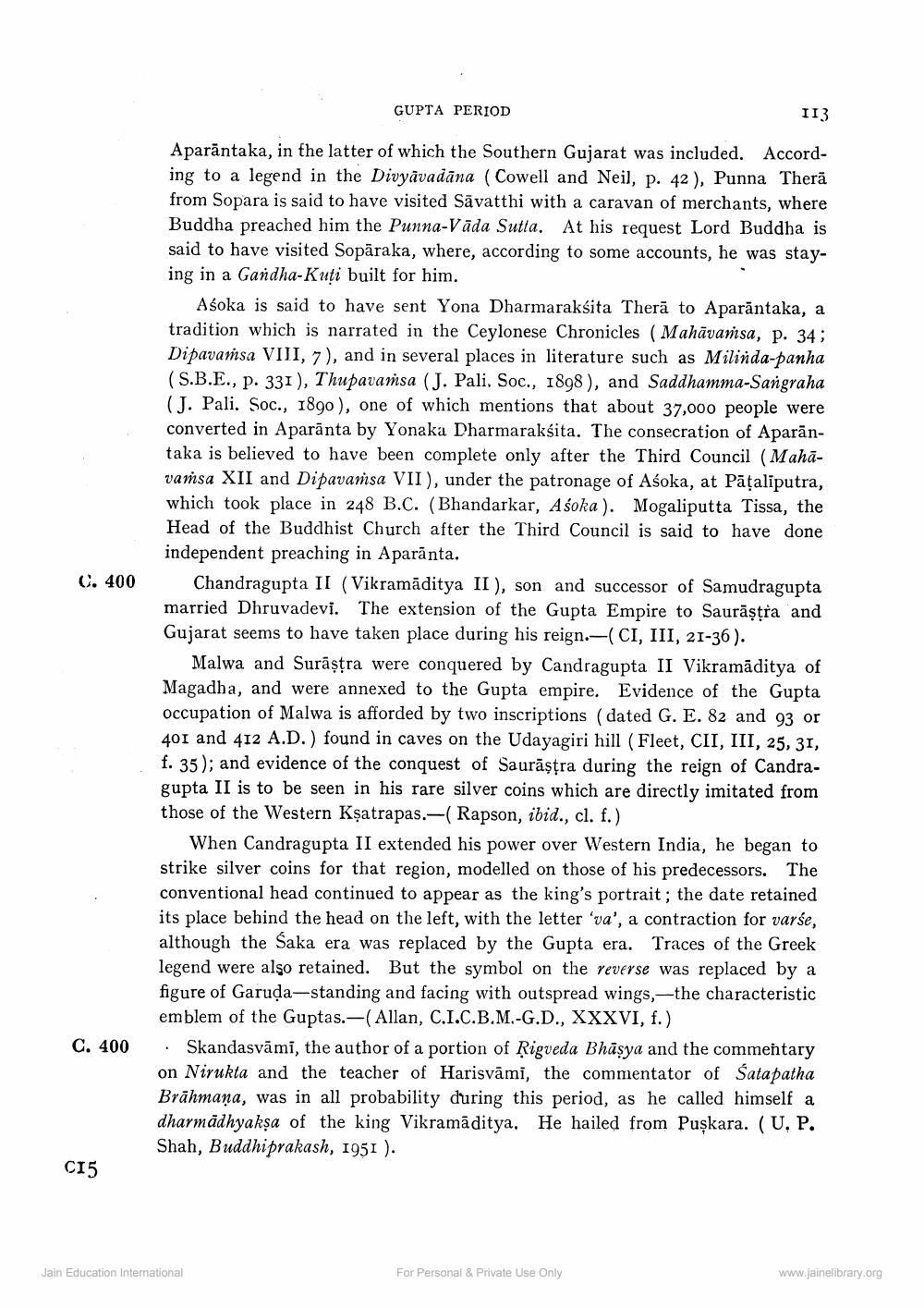________________
GUPTA PERIOD
I13
C. 400
Aparāntaka, in the latter of which the Southern Gujarat was included. According to a legend in the Divyāvadāna ( Cowell and Neil, p. 42), Punna Therä from Sopara is said to have visited Sävatthi with a caravan of merchants, where Buddha preached him the Punna-Vāda Sutta. At his request Lord Buddha is said to have visited Sopäraka, where, according to some accounts, he was staying in a Gandha-Kuți built for him.
Asoka is said to have sent Yona Dharmaraksita Therā to Aparāntaka, a tradition which is narrated in the Ceylonese Chronicles (Mahāvaṁsa, p. 34; Dipavamsa VIII, 7), and in several places in literature such as Milinda-panha (S.B.E., p. 331 ), Thupavamsa (J. Pali, Soc., 1898), and Saddhamma-Sangraha (J. Pali. Soc., 1890), one of which mentions that about 37,000 people were converted in Aparānta by Yonaka Dharmarakśita. The consecration of Aparāntaka is believed to have been complete only after the Third Council (Mahāvamsa XII and Dipavamsa VII), under the patronage of Asoka, at Pāțaliputra, which took place in 248 B.C. (Bhandarkar, Asoka). Mogaliputta Tissa, the Head of the Buddhist Church after the Third Council is said to have done independent preaching in A parānta.
Chandragupta II (Vikramāditya II ), son and successor of Samudragupta married Dhruvadevi. The extension of the Gupta Empire to Saurāştra and Gujarat seems to have taken place during his reign.-(CI, III, 21-36).
Malwa and Surāşțra were conquered by Candragupta II Vikramāditya of Magadha, and were annexed to the Gupta empire. Evidence of the Gupta Occupation of Malwa is afforded by two inscriptions (dated G. E. 82 and 93 or 401 and 412 A.D.) found in caves on the Udayagiri hill (Fleet, CII, III, 25, 31, f. 35); and evidence of the conquest of Saurāşțra during the reign of Candragupta II is to be seen in his rare silver coins which are directly imitated from those of the Western Kşatrapas.-( Rapson, ibid., cl. f.)
When Candragupta II extended his power over Western India, he began to strike silver coins for that region, modelled on those of his predecessors. The conventional head continued to appear as the king's portrait; the date retained its place behind the head on the left, with the letter 'va', a contraction for varše, although the Saka era was replaced by the Gupta era. Traces of the Greek legend were also retained. But the symbol on the reverse was replaced by a figure of Garuda-standing and facing with outspread wings,--the characteristic emblem of the Guptas.-(Allan, C.I.C.B.M.-G.D., XXXVI, f.)
Skandasvāmi, the author of a portion of Rigveda Bhāşya and the commentary on Nirukta and the teacher of Harisvāmi, the commentator of Śatapatha Brāhmaṇa, was in all probability during this period, as he called himself a dharmādhyaksa of the king Vikramāditya. He hailed from Puskara. (U, P. Shah, Buddhiprakash, 1951 ).
C. 400
C15
Jain Education International
For Personal & Private Use Only
www.jainelibrary.org




